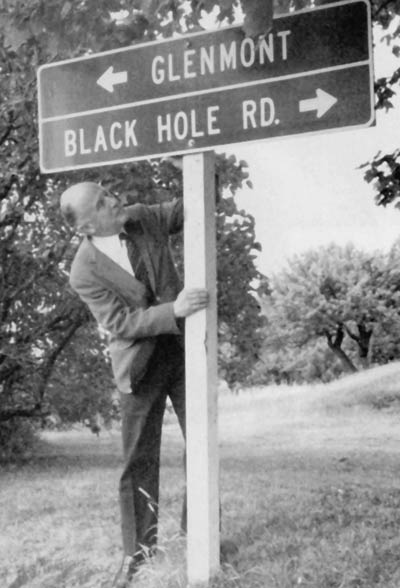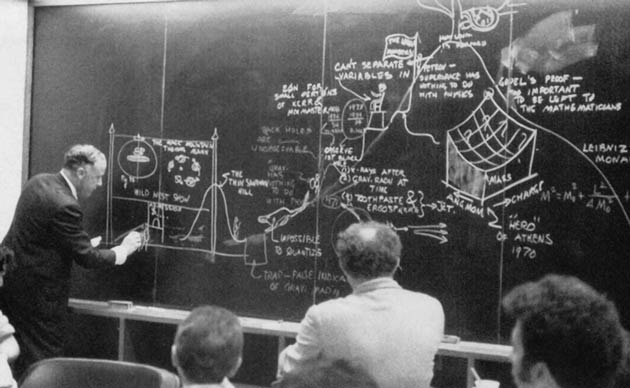
This Article From Issue
March-April 1999
Volume 87, Number 2
DOI: 10.1511/1999.20.0
Geons, Black Holes, and Quantum Foam: A Life in Physics. John Archibald Wheeler. With Kenneth Ford. 380 pp. W. W. Norton and Company, 1998. $27.95.
The book gets off to a cracking start. Half a dozen pages in we have met Bohr, Fermi, Einstein, Oppenheimer, Feynman and Gamow. These men are struggling to understand the atomic nucleus and they are aware of the terrible power that is locked in the heart of every atom. Meanwhile, in Europe, the storm clouds of war are gathering.
John Archibald Wheeler was in the thick of the race to tap the destructive power of the atom. He willingly put his blossoming scientific career on hold to join the cadre of bomb designers working on the Manhattan Project. Wheeler's story offers an insider's insights into the war effort. We learn that the Germans had mistakenly pursued graphite as a moderator and were far from a working bomb even as D-day approached. The U.S. atomic scientists were kept in the dark about this failure, to maintain the pressure on them to succeed. We learn that the Japanese conducted a partially successful incendiary bombing campaign on the western U.S. This was also kept quiet to avoid public panic.

From Geons, Black Holes, and Quantum Foam.
Unadorned patriotism led Wheeler to become involved in the post war effort to develop a hydrogen bomb. This second phase of the arms race had less public support, and Wheeler was taken aback by the censure of many of his colleagues. Wheeler's earnestness translated into naivete in the political arena—he seemed unaware of the moral and political ambiguities of the tense arms race with the Soviets. His friends were dismayed by his close ties with Edward Teller. To many people Teller is a figure out of Dr. Strangelove; to Wheeler he is just a physicist and a friend.
Wheeler has the bright core of curiosity that dwells in every child, and it has not dimmed even after a long and rich life at the heights of his profession. As a youth, he exploded bottle rockets indoors, and he once touched a 11,000-volt power line to "see what it would feel like." We can see the intellectual lineage of the successful scientist. Wheeler learned the art of deeply questioning nature from Neils Bohr, and he passed it on to his successful students, such as Kip Thorne. He positively glows with parental pride when he talks about "my brilliant student Dick Feynman."
Wheeler comes from a family of Puritans and librarians. The parsimony shows—his emotions are undoubtedly deeply felt, but they are not deeply expressed on these pages. (The glowing exception is his love for Janette, his wife of over 60 years.) He notes that if he had started his war effort a year earlier, he might have helped save 15 million lives, his brother Joe's among them. He expresses distaste for the eccentricities of Leo Szilard and the arrogance of Robert Oppenheimer. The reflections of his work on nuclear deformation are tinged with regret; the Nobel Prize was awarded to another group after Bohr and Wheeler were slow to publish. We enter the company of a man who says, "I have to admit that I never stop thinking about physics." And at one point he writes, "I was never much for small talk."

From Geons, Black Holes, and Quantum Foam.
Yet this parsimony is not evident in his approach to science. He displays a dazzling fecundity of ideas. Throw away Occam's razor. "Whatever can be, is," Wheeler believes. He divides his own career into three phases. In the first, he pursues the premise that "Everything is particles" by speculating on the properties of polyelectrons—matter consisting purely of positrons and electrons. Next, his aesthetic distaste for the notion of particles as singularities leads him to wonder whether or not "everything is fields." We learn that a self-contained bundle of fields might mimic the gravity of an entire star; this exuberant entity is the geon of the book's title. Last, his deep consideration of entropy and time leads him to the idea that "everything is information." Nearly 70 years after his Ph.D., Wheeler's mind is still roaming.
At age 41—well past the prime of a theorist—Wheeler was seduced by gravity and pursued it with a youth's ardor. Until then, general relativity had been an esoteric mathematician's playground. The early successes of the weak field theory had long ago been logged and digested. Wheeler pushed the theory's limits and was concerned with big effects. He explored the properties of black holes, wormholes and gravitational waves: the rips and shudders of spacetime. His legacy is the 1,300-page masterwork Gravitation and the rejuvenation of the field of gravitational physics.
Geons, Black Holes, and Quantum Foam contains reminders of a gentler age in science. Competitive juices flow in Wheeler, but he would much rather ruminate at length than publish quickly to eclipse a rival. He and his famous colleagues are generous with their time and their ideas, often removing their names from a paper if they feel their contribution has not been central enough. (Of course, it is also a traditional time; his colleagues are almost exclusively male, and wives and children are shadowy figures that follow the nomadic life of the academic.) Wheeler recalls a time when the entire community of quantum physicists could gather in a small inn on Long Island. He even delivers a paean to the pleasures of thinking on trains.
This is not an easy book for the general reader. Physics is explained along the way, but the text is dense with ideas and technical insights. Names flow thick and fast, and it may be difficult for the nonphysicist to keep them all straight. But the reader's effort is rewarded with a sweeping view of 20th-century physics. Wheeler has always been attracted to the profound issues, such as action at a distance, the complementarity principle and the fundamental nature of particles and fields.
Geons, Black Holes, and Quantum Foam is a pleasure thanks to the scientist it illuminates—a man of unsinkable confidence, fundamental decency and insatiable curiosity.
American Scientist Comments and Discussion
To discuss our articles or comment on them, please share them and tag American Scientist on social media platforms. Here are links to our profiles on Twitter, Facebook, and LinkedIn.
If we re-share your post, we will moderate comments/discussion following our comments policy.